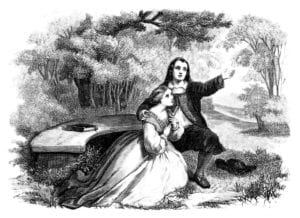Sonnets 141 - 154
Sonnet 141
Summary: the poet informs the Dark Lady it is not her physical beauty nor for any other charms –voice, touch, taste, smell – that engage his love. Rather it is because of “one foolish heart” that he loves her, though she treats him as a “slave and vassal wretch”, rewarding his devotion with “pain”.
Note: alongside the expected rhyme scheme, Sonnet 141 resonates with internal rhyme: for example, “despise / despite / delighted / desire” (lines 3 – 7) and “Dissuade / unswayed” (lines 10 – 11). Metaphors come from religious fields (“faith … errors … sin …”), alongside the world of health (“plague”) and law (“awards”).
Question: what is the effect of the switch from the second-person pronoun to the third in the closing line?
Sonnet 142
Summary: the poet denies that he should feel guilty for loving the Dark Lady – or if he should, she is not the one to reprove him, promiscuous as she can be. Rather she should feel pity towards him, and allow herself to respond sexually towards himself as she desires of others.
Note: metaphors are drawn from fields including religion (“sin … sinful … profaned …”) and law. Lines 7 and 8 represent kisses as “seal’d false bonds” that have deprived others of the “revenues of their rents”: in other words, our illicit liaisons have short-changed our legal partners of their conjugal rights.
Question: identify three ways in which Sonnet 142 is far from a conventional “love poem”.
Sonnet 143
Summary: the poet compares his pursuit of his amorous lover with a child chasing its mother – who in turn is chasing an escaping fowl as the lover chases other sexual partners. This domestic simile is extended beyond the volta as the poet begs the Dark Lady to return to himself to “still” his “crying”.
Note: the poet presents himself as a “poor infant” and a “neglected child” incapable of doing anything without the “careful housewife”. The “feathered creatures” she pursues may be courtly types with an eye to a well-dressed image. Line 13 suggests that the Dark Lady may have more than one lover named Will.
Question: do you agree that the closing lines of this sonnet re-think the closing couplet of Sonnet 142?
Sonnet 144
Summary: the poet suspects the Dark Lady has tempted “the fair youth” from his side to share her bed. Indeed he suspects they are lovers – he cannot “yet directly tell”, but he guesses as much. He concludes with the thought that he will not know for sure until the Dark Lady tires of the youth.
Note: the poet’s anxieties are expressed through a binary opposition underwritten by religious imagery: “angel … spirit … evil … saint … devil … purity … fiend … hell …” etc. But despite the religious lexicon, the poem ends on a distinctly human note: he will have to wait and see whether the relationship lasts.
Question: is it significant that this is Sonnet 144? Does the numbering of the sonnets in general have any significance?
Sonnet 145
Summary: the poet recalls a past incident with a much-desired lover. Evidently she begins a sentence with the words “I hate …” and pauses long enough for the speaker to fear how this sentence will end. As he waits nervously “did mercy come” to “her heart” and she finishes the sentence “not you”.
Note: the previous 144 sonnets have been composed in pentameters: in contrast, this sonnet is conveyed in tetrameters, investing it with an incongruously light touch (given the subject matter and the speaker’s evident unease). The ending, though not exactly happy, at least averts disaster.
Question: are you convinced by the idea that the closing couplet contains two references to the poet’s wife?
Sonnet 146
Summary: the poet believes any conflict between body and soul has seen the body triumphant, to the detriment of his “Poor soul”. But the body’s fate is ultimately to be consumed by worms, so now it is time to attend to the soul, and forsake the body in preparation for death.
Note: a religious poem, though not specifically a Christian one. The poet, sensing time passing, represents his body as a house, its “outward walls” apparently robust but nonetheless a “fading mansion”. Time to focus on within, he believes. The missing word in line 2, incidentally – probably a compositor’s oversight – may be “Feeding”.
Question: what is denoted by the extensive financial imagery (“costly … cost … lease … spend …” etc) used here?
Sonnet 147
Summary: the poet describes his love (presumably for the Dark Lady) as “a fever” which his powers of reason are not able to resolve or cure. The result is a kind of madness – resolved, perhaps, by the firm conclusion he draws in the closing couplet: that the object of his love is “as black as hell”.
Note: the sonnet employs an extended metaphor of sickness (“fever … nurseth … sickly … physician … etc). Reason or detachment would play the part of the doctor but “Reason is past care” and anyway “Hath left me”. Ironically, perhaps, the poet succeeds in distancing himself from his love in the closing couplet.
Question: is there any evidence in his plays that Shakespeare regards love as a kind of “fever” or madness?
Sonnet 148
Summary: the poet returns to the theme of the previous sonnet, equating love with madness, reluctant to trust the evidence of his own eyes. After the volta, the poet acknowledges that he is blinded not by judgment but by tears, the more effectively to disguise the “foul faults” of his lover.
Note: the poet’s confusion is reinforced by his compulsive re-thinking (“Or, if they have …” etc), as much as by the somewhat heartfelt tone (“O me!”) and the conversational register (“no, / How can it?”). The closing couplet is an emphatic rejoinder to the five questions asked hitherto, as “Love” itself is addressed directly.
Question: how far does this sonnet extend the thinking of Sonnet 147, and how far does it contradict it?
Sonnet 149
Summary: the poet claims he is so devoted to the Dark Lady that where she has personal aversion to a third party, he will automatically share it – even against himself. Indeed, he is “proud” to serve her, and to “worship thy defect”, though he knows that such “blind” passion does not fully endear him to her.
Note: Sonnets 147 – 150 describe a confused cast of mind, reflected in repeated use of the interrogative. In Sonnet 148, the poet asks five questions in ten lines, here six in twelve. Both poems end with emphatic statements – though lines 13 – 14 of Sonnet 149 do not answer the questions the poet has asked.
Question: how far is the analysis in lines 1 – 12 reflected in the poet’s conclusion: “I am blind”?
Sonnet 150
Summary: the poet is perplexed to be drawn to a lover whose shortcomings and limitations – her “unworthiness” – he knows only too well. Indeed, he suggests that a more rational response would be to “hate” her. Surely, he asks, if he can love her for her faults, then he has every right “to be beloved” in return.
Note: the poet asks three questions – how do you persuade me that whatever you tell me is true? How do you convince me that your worst is better than the best of the rest? And how do you inspire my love when I really ought to hate you? These questions – which are perhaps unanswerable – are not addressed in the closing couplet.
Question: what is the question to which the closing couplet provides an answer?
Sonnet 151
Summary: sexual desire is not always compatible with the conscience, but when the poet’s lover accuses him of infidelity, he cautions they may be equally guilty of surrendering to the “gross body’s treason”. He still feels sexual desire for the Dark Lady, and adds that he is happy to “rise and fall” sexually for her.
Note: the tone of this complex poem, whose logic is at times opaque, is lightened (or lowered) by the innuendo implied in its final clause, a reference to the sexually-active male. A similar pun closes Sonnet 150, where the poet suggests that the Dark Lady’s “unworthiness raised love in me”.
Question: do these two examples of Tudor (or Jacobean) ribaldry reveal anything about the sonnets’ audience and purpose?
Sonnet 152
Summary: the poet concedes he has broken vows to others in his love for the Dark Lady, and she has broken vows of her own. But he feels he is “perjured most”, perhaps because of shortcomings on her part. In particular he has “sworn” (perhaps to himself) she is honest, and in this deceived himself.
Note: the poem is built around two registers of truth-telling: the law court provides images of deep oaths, breaches, swearing and perjury. Meanwhile, religion furnishes notions of vows, faith and truth. After the somewhat flippant conclusions to Sonnets 150 and 151, this poem, the last of the Dark Lady sonnets, engages a more serious tone.
Question: what precisely is the charge with which the speaker arraigns himself in this sonnet?
Sonnet 153
Summary: when Cupid falls asleep – the story goes – a nymph plunges his torch into cooling water, only for the water itself to become “a seething bath”, a cure for “strange maladies”. Now the poet himself needs “the help of bath” but “found no cure”. The only cure is his mistress’s glance.
Note: this sonnet and Sonnet 154 draw on a fifth-century Greek poem by Marianus Scholasticus, which describes the infectious nature of erotic love, both metaphorically and literally. Now the poet himself needs to be cured – perhaps of love and desire, perhaps of a medical condition – but “found no cure” other than his lover’s eye.
Question: to what extent do you agree that the poet’s mood in this sonnet is close to despair?
Sonnet 154
Summary: the poet re-tells the myth of Cupid’s torch, the nymph and the well of cool water. The water (as in Sonnet 153) “took heat perpetual” from the torch, providing a “healthful remedy / For men diseased”. The poet reports that when he visits his mistress, passion triumphs over disease and its treatments.
Note: Shakespeare seems to locate his apparent infection with venereal disease and his love for the woman by whom he was perhaps infected in the context of Classical mythology. His closing couplet states somewhat portentously that, despite the efforts of the nymphs to cool Cupid’s torch, love’s ardour and passion are enduring.
Question: is it daring – or is it tasteless – for Shakespeare to write about this subject in these terms?
One Hundred Word Endnote:
Shakespeare seems to have composed his 154 sonnets largely for private entertainment, circulated and appreciated among friends. Their existence was first revealed in a book by Francis Meres in 1598, and two were published in 1599, probably without their author’s permission.
The entire collection appeared in 1609, but there the certainties end. The identity of the dedicatee (“Mr W.H.”) is disputed, and anyway he is not necessarily the subject of the poems; at least two lovers are addressed, and probably more than two; and it is highly unlikely the poems were written in the order in which they are printed.




